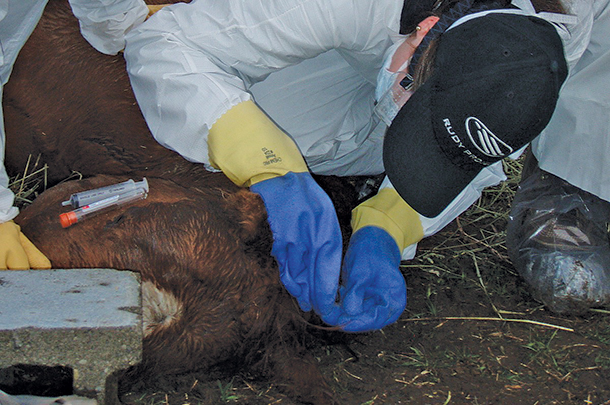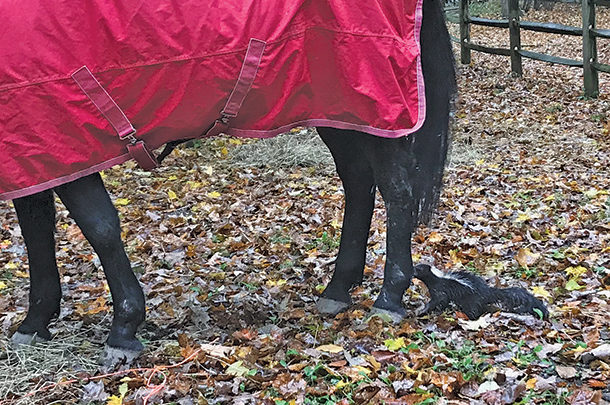Rabies occurs in all warm-blooded animals and is almost always fatal. This viral disease affects the nervous system, transmitted by saliva of an infected animal – usually with a bite or by saliva coming into contact with mucus membranes (such as the eye) or opening in the skin. This disease is uncommon in horses and cattle but occurs in these species when wildlife cases increase, with more opportunities for exposure. Rabies may be the last thing you suspect when a horse or cow gets sick, yet it’s important to keep this possibility in the back of your mind because this is the most serious disease humans can get from animals.
Dr. Julia Murphy, a state public health veterinarian in Virginia, says the number of rabid animals reported for each state is published annually on the CDC (Center for Disease Control and Prevention) website.
“Over the last 10 years, nationwide, there have been about 30 horses and 80 livestock (mostly cattle) laboratory-confirmed rabies cases each year. While domestic animals make up only about 10 percent of all cases reported, when a domestic animal gets rabies, it has a greater human health impact since more people have contact with these species than they do with wildlife,” says Murphy.
Vaccination decreases the likelihood of rabies. National guidelines (available at NASPHV Compendia) recommend vaccinating horses; the American Association of Equine Practitioners considers rabies a core vaccine.
“People should also consider vaccinating livestock,” she says. Check with your local health department or animal protection office to know which animals should be vaccinated for rabies by law.
“Though the number of cases reported in horses and cattle is relatively small in relation to total number of animals we diagnose each year, they frequently expose multiple people on the farm.” Signs of rabies in livestock are often vague in the early course of disease. You might suspect something is wrong with the animal but not think of rabies. That animal might be examined and treated for some other condition.
“If you suspect an animal might have rabies, take appropriate precautions to avoid contact with saliva. Any animal showing neurological signs or abnormal behavior should be considered a possible rabies case,” says Murphy.
Limit the number of people handling that animal. “Wear heavy gloves and eye protection to prevent exposure during treatment or handling – to help keep saliva from getting onto open areas of skin or into your eyes,” she says.
Rabies can be transmitted from the bite of rabid dog, cat, skunk, bat, etc. “The two infectious materials are saliva and central nervous system tissues, like brain tissue. This is an occupational risk for veterinarians trying to extract the brain of a dead animal to send to the lab for testing or laboratory technicians who are part of the process of assessing the brain.”
The main risk for horse owners or farmers and ranchers is contact with saliva. “If the horse or cow struggles when you are trying to tube them – as may happen if the problem is mistaken for choke or colic – the animal may be throwing its head and slinging saliva into your face or onto your skin.
“If you are trying to pass a tube or examining the mouth, you may get your fingers between the teeth or between the bottom teeth and hard dental pad in the front of a cow’s mouth. Cattle can crunch your fingers and break the skin, and this is enough to consider you exposed, if the animal is rabid,” Murphy explains.
“Though numbers of horses and cattle each year with rabies are small compared to other animals we diagnose with rabies, for every horse or cow there are probably several people who have been exposed and need to undergo post-exposure treatment.”
Any livestock people are in close contact with – show cattle, 4-H and FFA animals, etc. – should be vaccinated annually. “Keep rabies vaccinations up-to-date on all dogs and cats on the farm that may come in contact with livestock or horses. If any animal exhibits signs suggestive of rabies, discuss this with your veterinarian and work with local authorities to control feral cat and stray dog populations on the farm,” she says.
Ask your veterinarian where to obtain rabies vaccine and who should administer it. Rules vary from state to state.
“Here in Virginia, for vaccination to be recognized, it must be given by a veterinarian with proof of vaccination. In other states, information about rabies vaccine availability or who must administer it can be obtained from your state health department, department of agriculture or local veterinarian,” she says.
If horses or livestock become exposed (bitten by an animal that might be rabid), the procedure for dealing with the exposed animal may also vary from state to state. “Some states recommend that vaccinated horses and livestock receive a booster and then be observed for 45 days. For an exposed horse or cow that was not vaccinated, it’s often recommended that they be observed for a longer period,” says Murphy. Contact your state agriculture department or state department of health.

Dr. Dwyer and an intern doing a necropsy to remove the brain of a horse with suspected rabies. Photos provided by Heather Smith Thomas.
“In a situation where you think your horse or livestock may have been bitten by a high-risk species like a raccoon, skunk or fox, consider trying to capture it – but only if you can do it safely and not put yourself at risk. Contact your local animal control or local health department to see if the animal should be tested.” If you have to shoot it, don’t shoot it in the head, since the brain must be intact for testing.
Sings of rabies
Many people think rabid animals show aggressive behavior or salivate excessively (foaming at the mouth). “But rabid cattle may appear initially as choked because they can’t swallow or have muzzle tremors or bellow,” says Dr. Julia Murphy. Some of the signs might make you think they have some other problem. A cow may just go off-feed and look depressed.
“Initial signs of rabies in a horse may be abdominal pain or colic, or excessive drooling due to difficulty swallowing, or lameness. These initial signs can throw you off,” Murphy says. “In any animal, rabies should be suspected if they have rapidly progressing neurologic signs.”
Ann Dwyer, DVM with Genesee Valley Equine Clinic in Scottsville, New York, was involved in diagnosing three cases in horses with very different symptoms, illustrating the fact that rabies can look like just about anything. One mare was acting strangely and bellowing, aggressively lunging at anyone who came near her stall.
The second case was a horse that was dull, not eating, with a fever. “I thought the horse had flu, so I did a physical exam with my hands in its mouth and didn’t wear gloves,” Dwyer says. That horse showed no neurologic signs. It just wasn’t doing well, but by the next day it lost the ability to swallow.
“I sent the horse to Cornell University, still not suspecting rabies. Veterinarians at Cornell didn’t suspect rabies either and ended up with several people having to get post-exposure treatment. I also had to receive the treatment,” says Dwyer. “I was vaccinated for rabies while in vet school and got re-treated after each case I worked on,” she says.
The third horse came from Montana. The new owners in New York had been told the gelding had all his shots. “But later, we found he had not been vaccinated for rabies,” Dwyer says. This horse seemed lame. Then it acted colicky but not lame. The more we watched, the more puzzling it was. He was rapidly getting worse before our eyes. Children had been handling the horse, so we explained to the family about the possibility of rabies, and they were OK with euthanizing the horse,” Dwyer says. She did the post-mortem to remove its head, and it tested positive for rabies.
Cattle may be dull and lethargic or nervous and aggressive. Rabies may be mistaken for choke, wooden tongue – or a respiratory disease if the animal is dull and droopy. Sometimes the animal simply can’t eat or drink. In one case, a farm family was trying to get an orphaned calf to suck a bottle, and it refused to swallow. Several family members and neighbors tried to help with the calf, and later it was found to have rabies. Everyone who handled the calf had to take the post-exposure vaccinations.











